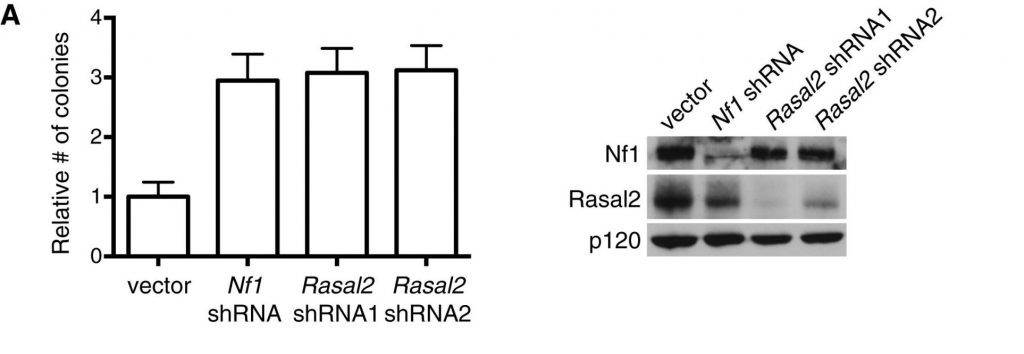RNA interference
Summary
RNA interference uses short RNA sequences complementary to a transcript of interest to decrease gene expression through transcriptional or translational silencing.
Also known as: RNAi, knockdown (different from knock-out); shRNA (“hairpins”) or siRNA
Samples needed: Generally used in living cells
Controls: Usually qPCR (add link) or Western blot are used to assess expression of gene of interest. Frequently, knockdown does not completely eliminate expression of the target gene. Furthermore, sh or siRNAs with different sequences will silences gene expression to different extents. Therefore, an analysis of the degree of silencing is a critical control and should always be shown.
Furthermore, in order to assess baseline levels of expression, a negative control si or shRNA should be used. Often, researchers will use an RNA that targets GFP, which is not normally present in cells outside of certain marine organisms, like the jellyfish from which GFP was first isolated. Sometimes an empty vector is used.
Lastly, when designing sh or siRNAs, researchers should always check that the target sequence does not appear in the genome anywhere besides the gene of interest. Otherwise, there can be unintended effects due to silencing of multiple genes.
Method:
siRNAs (small interfering RNAs) are short, ~19-21 basepair pieces of double-stranded RNA. They are processed by endogenous machinery in many cells, resulting in a temporary decreased expression of the target gene, usually on the scale of a few hours to a few days. siRNAs are transfected (add link) into cells, and once they degrade, expression of the gene of interest reverts to normal levels.
shRNAs (short hairpin RNAs) are longer than siRNAs and have a tight, hairpin turn on one end. When shRNAs are present in many cells, endogenous cell machinery processes them into siRNAs. shRNAs have the advantage of being delivered on a plasmid or viral vector. If the plasmid or vector contains a resistance gene, cells can be selected so that only those with genomic integration of the plasmid or vector remain. shRNAs can also be conditionally expressed, so that the gene of interest is only targeted upon administration of a certain compound, such as doxycycline. This allows for transient knock-down of genes whose complete knock-down would be lethal to the cells.
Interpretation:
Figure 1. RNAi used to assess effect of loss of gene expression on colony formation (add link) in soft agar. Relevant section of caption for published figure reads: “(A) Left: immortalized MEFs were infected with lentiviral shRNAs that target Rasal2, Nf1, or control and were plated in soft agar. Data are reported as relative number of colonies ± SEM. Inactivation of Nf1 or Rasal2 induced a statistically significant increase in anchorage-independent growth (p ≤ 0.0001). Right: western blot confirming knockdown.” “Figure 1” by Sara Koenig McLaughlin, Sarah Naomi Olsen, Benjamin Dake, Thomas De Raedt, Elgene Lim, Roderick Terry Bronson, Rameen Beroukhim, Kornelia Polyak, Myles Brown, Charlotte Kuperwasser, Karen Cichowski[1]. [Image description]
In Figure 1 above, the authors show that loss of expression of either Nf1 or Rasal 2 results in three times as many colonies in a soft agar colony formation assay. Importantly, they verify that Nf1 and Rasal 2 ebxpression is actually decreased by performing a Western blot (right). The reader can see that expression of the Nf1 protein is decreased by the Nf1 shRNA but not the Rasal2 shRNAs or the empty vector control. Rasal 2 shRNAs only decrease Rasal2 protein expression, and Rasal2 shRNA1 is more effective than Rasal2 shRNA2. (These two shRNAs are complementary to different parts of the Rasal2 sequence.) Finally, the empty vector control has no discernible effect on Nf1 or Rasal2 protein levels.
Image Descriptions
Figure 1 image description: A bar graph and Western blot. The bar graph shows relative number of colonies. Nf1 shRNA, Rasal2 shRNA1, and Rasal2 shRNA2 all have three times as many colonies as vector control. The Western blot shows loss of Nf1 expression only with Nf1 shRNA. Rasal2 shRNA1 shows nearly complete loss of Rasal2 expression; Rasal2 shRNA2 shows loss of most Rasal2 expression. p120 loading control is consistent in all samples. [Return to Figure 1]
- McLaughlin, S. K., S. N. Olsen, B. Dake, T. De Raedt, E. Lim, R. T. Bronson, R. Beroukhim, K. Polyak, M. Brown, C. Kuperwasser, and K. Cichowski. 2013. The RasGAP gene, RASAL2, is a tumor and metastasis suppressor. Cancer Cell 24:365-378. ↵
Green fluorescent protein
DNA molecule used to transport exogenous genetic material into a cell
Small, circular, extrachromosomal DNA molecule that can replicate independently
Mouse embryonic fibroblasts, for growing in cell culture


